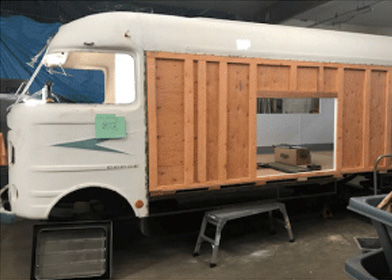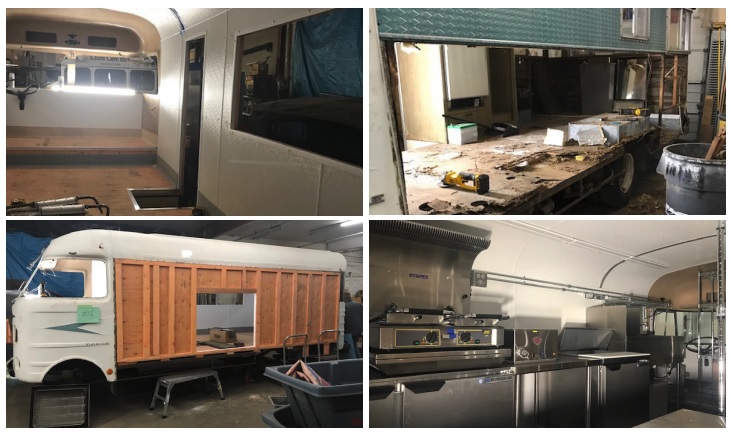
Case Study: Chrysler Food Court
Boelter has partnered with Compass on numerous food service jobs, averaging 15-20 per year over the past 10+ years. However, this was the first design initiative with Compass that focused on a food truck. It was an opportunity to extend and further solidify an already strong relationship, as well as to be involved in what was certain to become one of the more interesting and unique projects to date.
Considering that Chrysler is located in Detroit–the automobile capital of the world–Boelter worked with Compass to develop a fitting theme, while ensuring that the final output would seamlessly tie back to its roots within the automobile industry. It was also understood that the final version of the food truck needed to accommodate for what would undoubtedly be a high level of lunchtime traffic.

Deciding on a 1965 Dodge Chinook Mobilodge as the starting point was a perfect fit and checked every box. Initially, the idea was to design and develop a more traditional, fully functioning restaurant on wheels, capable of providing food service across all of Chrysler’s extensive campus buildings. However, after further consideration, it was determined that a “fixed” food station would be a better option. Adding to Chrysler’s existing corporate cafeteria–one that offers a salad bar, deli and grill–the Street Eats food truck is capable of delivering a more interesting and thematically dialed-in choice during the noon-hour rush.
The decision to develop a non-mobile food truck included the requirement to overhaul the vehicle, completely remove the engine in order to lighten its total weight and gut the body of the ’65 Chinook, in some spots, down to the frame. The condition of the truck that was being modified determined how much of the original body and structure remained. This was based on a comprehensive list of safety requirements, as well as ensuring that every modification was up to code.
When the project was complete, it became a unique opportunity for Compass to serve the employees at Chrysler, a design well out of the norm and unlike anything generally experienced within a corporate cafeteria setting.

SELF-CONTAINED FOR SAFETY AND CONVENIENCE
Most food trucks vent their cooking appliances directly into the air where they operate and conduct business. Due to the fact that this Street Eats food truck would be functioning and serving food inside the Chrysler cafeteria, extra steps were taken to ensure proper safety codes were stringently observed. This included the removal of any and all gas-based equipment, as well as the assurance that all cooking appliances inside the food truck were accurately installed and delivered the proper levels of ventilation.
Much of the food service equipment pieces selected needed to be self-contained with their own set of ventilation hoods. These units are specifically designed to intake the hot air emitting from the equipment and recycle it through its own filtration system. Other equipment options that were considered also included their own catalytic converters. The aroma that the food emits while being prepared is still present, but the grease-laden particles are removed, and the circulated air remains fresh.
One of the appliances installed during development was the Perfect Fry, a ventless and hoodless countertop deep fryer capable of accommodating for its own fire system and allowing for a variety of fried food to be prepared. An electric panini grill was also installed, but with an accompanying counter top hood system that intakes the air from the top of the appliance, runs the hot air through a charcoal filter and disperses clean air back out into the environment. This ventilation system removes smoke, grease-laden air, moisture and odors, improving the environment for both the food truck staff and customers. It's certified to meet EPA 202 test method in accordance with NFPA 96. Employing these self-contained appliances was a direct response to the unique, indoor requirements of the Chrysler food court.
The increased concern of fire and environmental safety was always top of mind as the food truck was being designed and tested prior to delivery and installation. Adding to this was the prerequisite that the food truck also demanded its own utility distribution center, one that was capable of providing the necessary levels of electricity from a single circuit to feed all of the various appliances with consistent power.
MEASURING FOR SUCCESS
The planning, designing and implementation of this unique food truck was completed in Minneapolis, Minnesota. Once finished, the 1965 Chinook was wrapped in protective plastic, lifted onto a flatbed transport and carried across two states before arriving in Detroit, Michigan.
Parking the food truck at its final destination was a process in and of itself. Door openings required accurate measurements in order for the vehicle to fit through the building’s entrance. Even with the many advantages of it being the Chrysler building, where vehicles are often moved in and out on a regular basis, proper measurements needed to be checked (and re-checked) to verify the Chinook would make it to its final resting place, free of incident or damage.
Because both the vehicle’s engine and transmission were removed during the early stages of development, it took the effort of several workers to physically push the food truck through the door opening and across the food court before making the final electrical connections and readying it for testing and, eventually, opening for business.
AN EXERCISE IN CREATIVITY, INGENUITY AND TEAMWORK
Over the course of approximately four months, Boelter and Compass worked closely to identify the vision, plan out and refine the details, and locate and obtain the perfect vehicle in order to bring this project to life. It was a learning experience for everyone involved and one that demanded a heightened sense of creativity and thinking outside the normal foundations of what has historically been considered when designing and developing a food truck.

This innovative project was managed by Eric Chaplick and Bill Rzasa. To get started on your food truck or food service project, contact us today.
